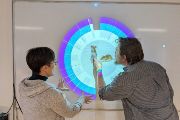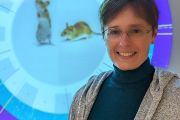
diem: a breakthrough method will change genome research
21. 11. 2022
Thanks to scientists from the Institute of Vertebrate Biology of the Czech Academy of Sciences, what used to take days to weeks and computers with huge computing capacity will be faster and more reliable. They developed "diem", a method of genomes polarization, thanks to which experts around the world across disciplines can more easily analyze genomes. It will be appreciated, for example, by archaeologists when searching for Neanderthal genes in the genome of modern humans or biologists who can track advantageous chunks of genomes and further use them as biomarkers.
More than fifteen years of research has produced a great success that will benefit everyone
"diem, the method of genome polarization, is designed to allow us to quickly and efficiently find places in genomes where there is reduced gene flow between species. In other words, the places that are responsible for speciation, i.e. the emergence of new species," says the author of the method, Stuart J. E. Baird from the Institute of Vertebrate Biology of the Czech Academy of Sciences (IVB). At the same time, the method can also be used to find places where gene flow still occurs. "Such places can play an important role in the adaptation of organisms to environmental change, like the current climate crisis," explains Natália Martínková from the IVB, who has participated in the study for the past two years.
Uncovering "enhancing" genetic exchanges
In practice, diem would make it possible to see, for example, which parts of the Neanderthal genome are still present in the human genome. "Some Neanderthal genes are known to make human carriers of these variants more susceptible to various diseases," says Natália Martínková. Demonstrating the new method on mouse genomes, scientists found that two species of mice relatively recently exchanged part of their genetic information. It was known some populations of the western house mouse (Mus musculus domesticus) have acquired resistance to pesticides thanks to genetic exchange. The new analyses show the Mediterranean mouse (Mus spretus), in turn, has acquired genes that increase its sense of smell. "It appears both species of mice thus acquired genes that improve their characteristics, and therefore the ability to survive in an environment altered by humans," explains Natália Martínková.
"Just as polarising light microscopy revolutionised geology, so genome polarisation gives us an entirely new way to view the genetics of life," summarizes Stuart J. E. Baird. The new method will be especially appreciated by archaeologists when searching for archaic sections in the human or other genomes, evolutionary biologists will be excited by the possibility of tracking advantageous sections of genomes captured across species, and ecologists will have the opportunity to use such sections in genomes as biomarkers of earlier expansions.
Genome polarization can process giant genomes quickly and efficiently
Scientists have been interested in the origin of species for centuries. With the discovery of PCR (polymerase chain reaction) in 1983 and the subsequent advent of molecular genetics, they had the tool to study the evolution of individual species or entire groups. "Thanks to molecular genetics, we discovered, for example, that there is a hybrid zone of hedgehogs, bats or mice in the Czech Republic. In other words, multiple pairs of different species or subspecies meet here," explains Stuart J.E. Baird. Scientists were also able to calculate when these species diverged from each other and with good sampling effort in the field, the strength of barriers to movement of genes between them. Later, thanks to "next-generation sequencing" methods (massively parallel sequencing), scientists gained the tools to examine entire genomes. In other words, to obtain even more detailed information about the evolution of organisms.
“But the problem with genomes is that they're huge. For example, the mouse genome has 2,716,965,481 base pairs, the human genome’s DNA is only a foot (about 10%) longer," explains Natália Martínková. Sometimes scientists say that a single genome contains as much text as a small-town library.
"Until recently, genome analyzes with these goals were complex multi-step processes that took several days or weeks required computers with huge computing capacity, or analyses were run via remote servers," adds Stuart J. E. Baird. Thanks to diem, such analyses are now simpler, more reliable, and much faster, running within hours on a single laptop.
A long road to a breakthrough discovery
Science has become a very competitive environment where the rule "publish or perish" applies and quick, almost instant results are favoured. Researchers have to compete for money for their projects in national or international competitions, and the successful team receives funding for an average of 3-5 years. During this time, the team must produce results that scientific international journals will publish and thus make available to researchers. Scientists doing long term research don't have it easy, but they can still succeed.
The story of the creation of the new method for genome analysis is an example of the benefits of long term research. Stuart J. E. Baird, a scientist from a small institute of the Czech Academy of Sciences, developed the new method over the course of 15 years. During this research, Stuart Baird was funded by the Czech Grant Agency motto: “We support fundamental research” however his last grant application was rejected “because the work was about methods, not results”. During the final year of development, his research was directly supported by his institute. "Without the support of management and colleagues for long term research, I would not have been able to complete this project," concludes Stuart J. E. Baird.
Publication online:
Genome polarisation for detecting barriers to geneflow - Baird - Methods in Ecology and Evolution - Wiley Online Library
https://www.biorxiv.org/content/10.1101/2022.03.24.485605v3
Contact:
Dr. Stuart J. E. Baird
Institute of vertebrate Biology of CAS
e-mail: stuartj.e.baird@gmail.com
Read also
- Ecological production of photovoltaic systems in Europe within striking distance
- How to survive global warming: bank voles borrow a gene from their neighbors
- Praemium Academiae 2022
- Hundred-year-old riddle in botany reveals key plant adaptation to dry land
- This discovery offers a new way of defence against RNA viruses in humans
- The secrets of the transport of substances inside cells to be explained
- Autonomous vehicles: ethically sound decisions in case of an accident?
- The latest genetic methods for food safety and sustainable agriculture
- During the Researches’ Night, you experience science with all your senses
- Archaeologists uncover a unique Stone Age building on the outskirts of Prague
Contacts for Media
Markéta Růžičková
Public Relations Manager
+420 777 970 812
Eliška Zvolánková
+420 739 535 007
Martina Spěváčková
+420 733 697 112




